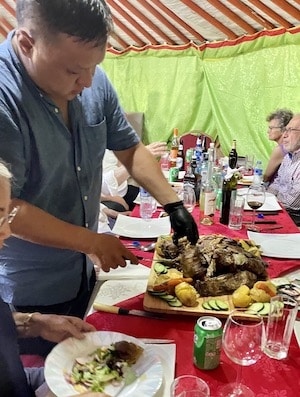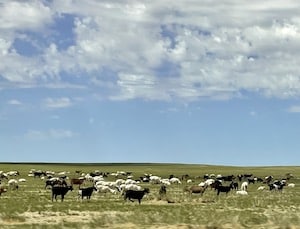
Even though his questions are now memories, I still look for the story beyond my plate wherever I go. And, oh the places we did go this summer — from Colorado to Mongolia with Seoul in between! From the mountains to desert and sea, our food is truly a reflection of culture and land intertwined.
Trekking Across the Land of the Eternal Blue Sky
What a unique opportunity my husband and I had this summer exploring the “Land of the Eternal Blue Sky” with a 16 member Ulaanbaatar/Denver Sister Cities Committee delegation, led by good friends and colleague, Mary Lee Chin, MS, RDN and her husband, Jim Wagenlander, the Honorary Consul General to Mongolia. For some, this ancient land is hardly known, but when you experience it through the eyes of its citizens and those that have known it for 30 years, the endless sky tells a story beyond the view.
While this was not a food or farming related trip, one does become intrigued to understand the “farm to plate connection” when livestock outnumber people! Mongolia, a landlocked independent country between China and Russia, is home to one of the last nomadic people with herdsmen moving their millions of head of livestock across the steppes and desert during the warm months to find food and water and trying to keep them alive during the winter.
With a population of approximately three million in a country almost the size of Alaska, it is the world’s least densely populated country except in the cities. Today, about 45% of the population lives in the capital city of Ulaanbaatar. Overall, 70% of Mongolians now live in the cities, not the pasturelands; a population trend that is not unique to Mongolia.
It’s Our Culture


Over the years, international influence, economic influx, and television cooking shows have given rise to more variety in the diet (including fruits and vegetables) and a vibrant food scene, especially in the capital city.
It’s Still About the Land

With harsh winters and frequent moving of herds during the warm months, the planting of agricultural crops or gardens are minimal to none. While water supply, climate, soil quality, and crop production knowledge are key to growing food in the U.S., they are barriers in Mongolia.
Food Supply Needs or Wants?
We eat beyond our borders, regardless of where we live! In the U.S., our palates and purses demand variety year-round. Even though the U.S. supplies approximately 86% of what we eat, the expectations for year-round accessibility to cultural delights and fresh produce has increased our reliance on other countries. For example, Mexico and Canada provide more fresh varieties of fruits and vegetables than is grown here.
For Mongolia, it’s quite the opposite! It is estimated that 95-99% of the food consumed in Mongolia comes from crops not grown in the country. The country’s reliance on China, South Korea and Japan for produce is a “need, not a want.” Even though our hosts told us more produce was being grown in greenhouses around the capital city, the supply is limited, and costs are higher.
With approximately one percent of the land suitable for crop production and a short growing season, Mongolia is limited to what it can grow; it’s primarily spring wheat with some barley and oats, along with potatoes and vegetables such as cabbage and carrot. In fact, Mongolia is considered self-sufficient in wheat and potato production along with livestock and dairy. But for the nomads, the benefit of animal production extends beyond food, it’s an economic driver. Think cashmere and wool!
Two Distinct Countries, But Common Challenges

Unfortunately, the changing agrarian lifestyle impacts health status as well. As described, the traditional Mongolia diet is high fat, high protein and calorie dense, which was a benefit for a nomadic lifestyle requiring lots of activity and survival of harsh climate conditions. But when lifestyles become sedentary and the calorie intake doesn’t change, problems arise. Mary Lee mentioned many Mongolian friends have expressed concerns about the subsequent rise in chronic diseases such as diabetes, gout, cancers and heart disease they have personally experienced or have seen affect their families — a situation which is all too familiar in the U.S.
It’s Not a Comparison, But Reality
While the U.S. and Mongolia are miles apart beyond the geographic realties, looking beyond our plates gives us perspective. Often, we “complain” about the complexity of the U.S. food system, but the food on our plates is not limited by geographic location or seasonal influence. We have the agricultural technology and ability to grow food for ourselves and others. Yet, both countries face the reality of a shrinking labor force, aging farmers and increasing health concerns. Food is complex but looking beyond our plates can bring solutions and most importantly, appreciation!
Note: Special thanks to Mary Lee Chin for her contributions to this blog-sharing her 30 years of insights and love of Mongolia.
